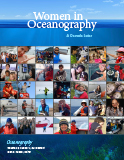AFT (American Federation of Teachers). 2009. The State of the Higher Education Workforce 1997–2007. American Federation of Teachers, 28 pp., http://www.aft.org/sites/default/files/aa_highedworkforce0209.pdf.
Banaji, M., and A. Greenwald. 2013. Blindspot: Hidden Biases of Good People. Delacorte Press, NY, NY, 272 pp.
Clem, S., S. Legg, S. Lozier, and C. Mouw. 2014. The impact of MPOWIR: A decade of investing in mentoring women in physical oceanography. Oceanography 27(4) supplement:39–48, https://doi.org/10.5670/oceanog.2014.113.
Glass, J. 2015 (May). We are the 20%: Updated statistics on female faculty in Earth sciences in the US. In Women in the Geosciences. M.A. Holmes, S. O’Connell, and K. Dutt, eds, American Geophysical Union and Wiley.
Holmes, M.A. 2014. Advancing women in oceanography: How NSF’s ADVANCE program promotes gender equity in academia. Oceanography 27(4) supplement:30–38, https://doi.org/10.5670/oceanog.2014.112.
Holmes, M.A., P. Asher, J. Farrington, R. Fine, M.S. Leinen, and P. LeBoy. 2012. Does gender bias influence awards given by societies? Eos, Transactions American Geophysical Union 92:421–422, https://doi.org/10.1029/2011EO470002.
Holmes, M.A., S. O’Connell, and K. Dutt, eds. 2015 (May). Women in the Geosciences: Practical, Positive Practices Toward Parity. American Geophysical Union, Wiley, 135 pp.
Huntoon, J.E., and M. Lane. 2007. Diversity in the geosciences and successful strategies for increasing diversity. Journal of Geoscience Education 55:447–457.
Kappel, E.S., and L. Thompson. 2014. Invited scientific papers and speakers and fellow awardees: Little progress for women oceanographers in the last decade. Oceanography 27(4) supplement:24–28, https://doi.org/10.5670/oceanog.2014.110.
Lozier, M.S. 2006. MPOWIR: Mentoring Physical Oceanography Women to Increase Retention. Eos, Transactions American Geophysical Union 87:123–126.
Moss-Racusin, C.A., J.F. Dovidio, V.L. Brescoll, M.J. Graham, and J. Handelsman. 2012. Science faculty’s subtle gender biases favor male students. Proceedings of the National Academy of Sciences of the United States of America 109:16,474–16,479, https://doi.org/10.1073/pnas.1211286109.
NSF (National Science Foundation). 2004. Division of Science Resources Statistics, Science and Engineering Degrees: 1966–2001. NSF 04-311, Project Officers, Susan T. Hill and Jean M. Johnson, Arlington, VA, USA, http://www.nsf.gov/statistics/nsf04311/sectb.htm.
NSF. 2013. Women, Minorities, and Persons with Disabilities in Science and Engineering. National Science Foundation, National Center for Science and Engineering Statistics, Special Report NSF 13-304, Arlington, VA, http://www.nsf.gov/statistics/wmpd/2013/start.cfm.
O’Connell, S. 2013. Consider nominating a woman for an AGU award. Eos, Transactions American Geophysical Union 94(10):99, https://doi.org/10.1002/2013EO100003.
O’Connell, S., and M.A. Holmes. 2005. Women of the academy and the sea. Oceanography 18(1):12–24, http://dx.doi.org/10.5670/oceanog.2005.66. Orcutt, B.N., and I. Cetinić. 2014. Women in oceanography: Continuing challenges. Oceanography 27(4) supplement:5–13, https://doi.org/10.5670/oceanog.2014.106.
Prendeville, J., and D. Elthon. 2001. Report of the Geosciences Diversity Workshop, August 2000, Appendix to NSF 01-53 (Strategy for Developing a Program for Opportunities for Enhancing Diversity in the Geosciences). Arlington, VA, http://www.nsf.gov/geo/diversity/geo_diversity_workshop_ final_report_august_00.jsp.
Steele, C.M. 1997. A threat in the air: How stereotypes shape intellectual identity and performance. American Psychologist 52:613–629.
Thompson, L., R. C. Perez, and A. E. Shevenell. 2011. Closed ranks in oceanography. Nature Geoscience 4:211–212, https://doi.org/10.1038/ngeo1113.

